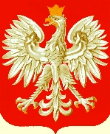Alphabets
|
| a |
ą |
b |
c |
ć |
d |
e |
ę |
| f |
g |
h |
i |
j |
k |
l |
ł |
| m |
n |
ń |
o |
ó |
p |
r |
s |
| ś |
t |
u |
w |
y |
z |
ź |
ż |
Note that the letter "
ą" is a separate letter from "a". Therefore, in proper Polish, “ą" follows AFTER "a" in the alphabet and in alphabetical listings. This is most important when reading gazetteers.Baz comes before
Bąk
"s" is sometimes written like a "f" in old cursive style found
in church records
Morofki = Moroski
town of Sasfów = Sassów
When looking at English or other non-Polish documents, you may find the following occurrences.
The Polish letter "ł" (which sounds like the English "w") is transcribed into English like an "l" or like a "w". You may find it as a "t" because a non-Polish speaking clerk mistook the "ł" to be a "t".
The Polish nasal vowels "ą" and "ę" may be transcribed into English simply as "a" and "e". Or because of the sound heard by a non-Polish speaking person, "ą" may be transcribed as "an", "on" or "am", "om". And then "ę" may be transcribed as "en" or "em".
Examples:
Lech Wałęsa is pronounced in English as "Va-wen-sa"
The last name Bąkowski
may have been changed to Bankowski or Bonkowski or
Bakowski
in English. The -an /-on would show that
the Polish nasal vowel sound has been retained.
Ukrainian Alphabet
(moving across from left to right)
|
а |
б |
в |
г |
ґ |
д |
е |
|
є |
ж |
з |
и |
і |
ї |
й |
|
к |
л |
м |
н |
о |
п |
р |
|
с |
т |
у |
ф |
х |
ц |
ч |
|
ш |
щ |
ь |
ю |
я |
It’s written in the Cyrillic alphabet. (They Cyrillic alphabet is based on an early Slavic alphabet created by Saints Methodius and Cyril, and their disciples. See "Origins" below.)
If you know the Russian alphabet, note the following important differences:
- Ukrainian I is Russian И
- Ukrainian И is Russian
Ы
- the Ukrainian letters i, ї
(i-with two dots)
and
є
(ye) are not found
in Russian
- the Russian letters ы,
э, ё,
ъ (hard
sign) are not found in Ukrainian
- the Ukrainian
г is always pronounced as a voiced
h, and not like a hard g sound as in Russian
the Ukrainian ґ was popularly used in Soviet times for the g sound in foreign words
- the "hard sign" is denoted in Ukrainian as an apostrophe
('), whereas in Russian it's the letter "ъ"
- the Ukrainian e is not iotated,
meaning it does not have the slight "y" sound in front of it as does the
Russian
e. The Ukrainian
e
is more like the Polish
e. (The Ukrainian e sounds like the
e in the English word "bet", the Russian e
as in the ye in "yet".)
- Ukrainians use
є for the iotated "ye" sound.
For more language tricks played on Polish and Ukrainian spelling, visit my page on Passenger Lists. There I describe some various spellings one could use when searching for relatives in Passenger Lists (or any other English language resource).
Origins of the Cyrillic alphabet
two Greek missionary brothers, Saints Constantine (later named Cyril) and Methodius, traveled to Slavic lands in the ninth century. The brother created analphabet, based largely on the Greek alphabet with some Hebrew and Armenian contributions, in order to translate Christian writings and help preach to the people in their own language. Although there is considerable debate, most scholars believe that Sts. Cyril and Methodius invented an alphabet called Glagolitic, which was still used in some Croatian church records as last as the early 20th century. Some time later, a modified and simplified version of the alphabet, which became the Cyrillic alphabet as we know it today, was most likely created by disciples of Cyril and Methodius. Nevertheless, Saints Cyril's and Methodius' devotion and work are immortalized by the name of the alphabet used today by approximately 355 million people, for languages including Russian, Ukrainian, Serbian, Bulgarian, and others.
|
www.halgal.com
Questions and Comments to Matthew
Bielawa |

